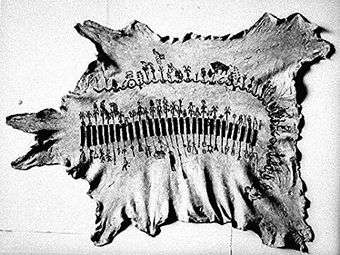Winter count

Winter counts (Lakota: waníyetu wówapi or waníyetu iyáwapi) are pictorial calendars or histories in which tribal records and events were recorded by Native Americans in North America. The Blackfeet, Mandan, Kiowa, Lakota, and other Plains tribes used winter counts extensively. There are approximately one hundred winter counts in existence, but many of these are duplicates.
Description
Most winter counts have a single pictograph symbolizing each year, based on the most memorable event of that year. For Lakota people, years ran from first snow fall to first snowfall.[2] Kiowa winter counts usually feature two marks per year – one for winter and one marking the summer Sun Dance.[3] The glyphs representing significant events would be used as a reference that could be consulted regarding the order of the years. More extensive oral histories were passed down using the winter counts as guide posts.
Traditionally each band would choose a single keeper of the winter count. Until the 20th century, these keepers were always men. They would consult with tribal elders to reach a consensus for choosing a name for the year. The keeper chose his successor in recording the count, who was often a family member.[2]
Until the late 19th century, winter counts were recorded on buffalo hides. When buffalo became scarce, keepers resorted to using muslin, linen, or paper.[2] The annual pictographs began on either the left or right side of the drawing surface and could be run in lines, spirals, or serpentine patterns.
History of discovery
Garrick Mallery, a Smithsonian scholar, recognized that one of those events, "The Year the Stars Fell," correlated with the Leonid meteor storm of November 1833. He used that event to correlate the Lakota winter counts with western calendars and analyze the histories of the peoples.[2]
Known winter counts
Oglala Lakota
- Tradition 1: No Ears, John Colhoff, Flying Hawk, Baptiste Garnier
- Tradition 2: Short Man
- Tradition 3: White Cow Killer
- Tradition 4: Iron Crow, Wounded Bear
- Tradition 5: Red Horse Owner
- Tradition 6: Cloud Shield
- Tradition 7: American Horse
- Tradition 8: Breast
Brulé Lakota
- Battiste Good and High Hawk
- Rosebud
- Swift Bear
- Swift Dog
- Iron Shell
Hunkpapa Lakota
- Iron Dog
- Lone Dog
- Long Soldier
- Major Bush
Miniconjou Lakota
- Swan
- Thin Elk / Wata Peta (Steamboat), 1821-1877[4]
Other Lakota, and Dakota
- Hardin Winter Count
- Mato Sapa
- Northern
- The Flame
Blackfeet
- Bad Head, 1810-1883, oral count recorded[5]
- Bull Plume, 1794-1924, survives only as copied drawings from 1912[5]
- Percy Creighton, 1831-1938[6]
Mandan
Kiowa
See also
Notes
- ↑ "Pictures of Indians in the United States." The National Archives. (retrieved 4 Feb 2010)
- 1 2 3 4 Hansen, 42-45
- ↑ Greene and Thorton, 300
- ↑ Sundstrom, Linea. "The Thin Elk/Steamboat Winter Count: A Study in Lakota Pictography", Buechel Memorial Lakota Museum, 2003 (retrieved 3 May 2010)
- 1 2 Greene and Thornton, 301
- ↑ Greene and Thornton, 314
- 1 2 3 Greene and Thornton, 302
- ↑ Greene and Thornton, 300
- 1 2 Greene and Thornton, 304
- ↑ Greene and Thornton, 306
- ↑ Greene and Thornton, 309
- ↑ Greene and Thornton, 310
References
- Greene, Candace S. and Russell Thornton, eds. The Year the Stars Fell: Lakota Winter Counts at the Smithsonian. Washington, DC: Smithsonian Institution, 2007. ISBN 0-8032-2211-4.
- Hansen, Emma I. Memory and Vision: Arts, Cultures, and Lives of Plains Indian People. Cody, WY: Buffalo Bill Historical Center, 2007:42-45. ISBN 0-295-98580-1.
External links
- Lakota Winter Counts: An Online Exhibit by National Anthropological Archives, Smithsonian Institution
- Anderson Winter Count, articles by Tanis Thorne
- Waniyetu Wowapi (Winter Count) - Reliable information and interesting lesson plans.
- Lakota Winter Count 1752-1899